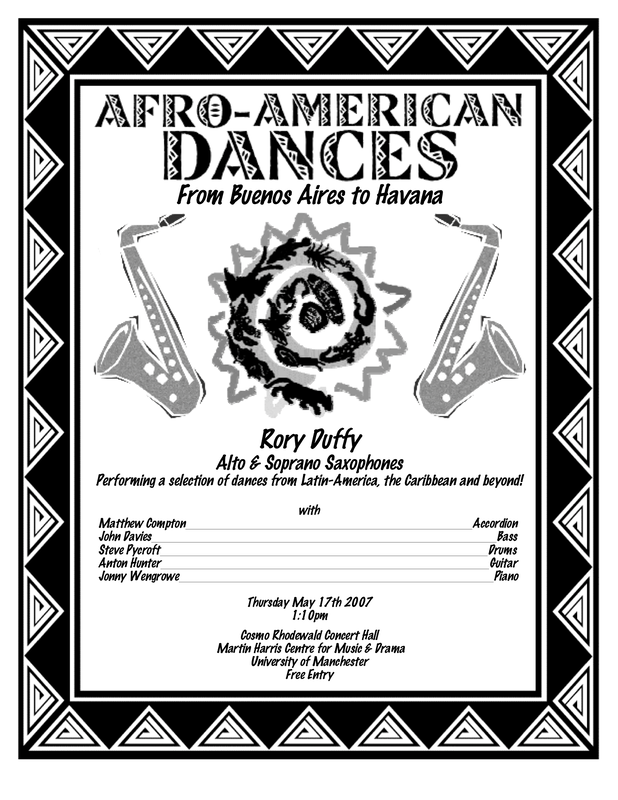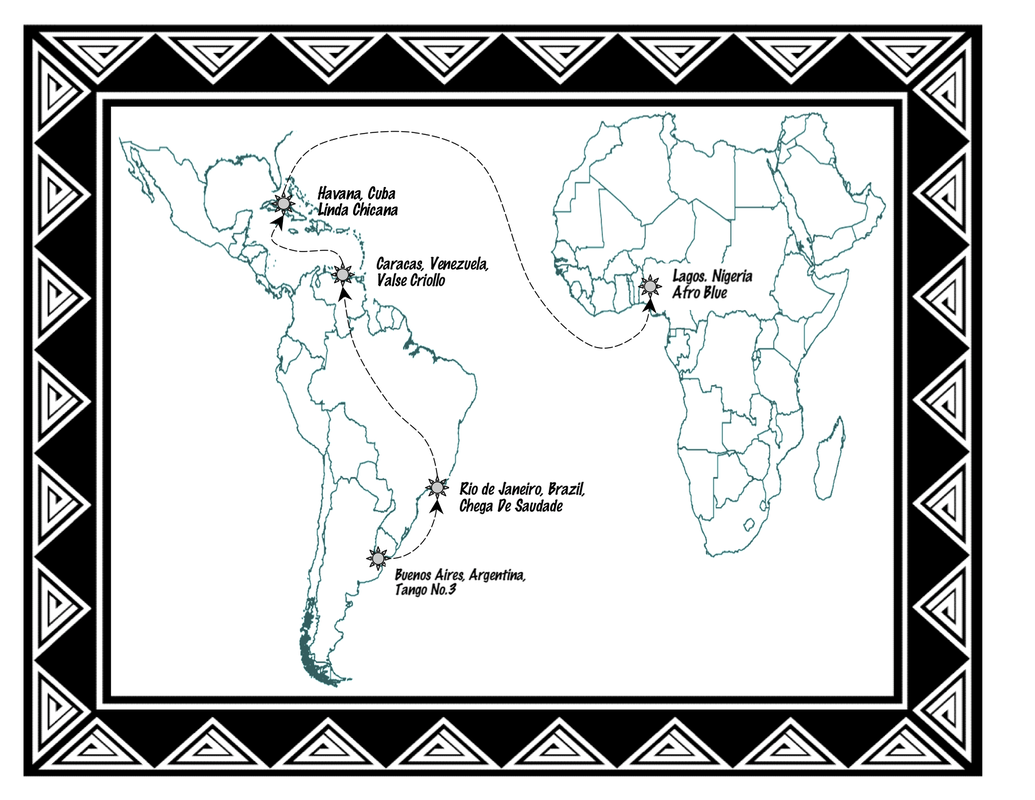Afro-American DancesRory Duffy (Alto & Soprano Saxophones) performing a selection of dances from Latin America, the Caribbean and beyond! with... Matthew Compton - Accordion Johnny D - Bass Stevey P - Drums Anton Hunter - Guitar Jonny Wengrowe - Piano - PROGRAMME - Astor Piazzolla - Tango No3 (Argentina) Antonio Carlos Jobim - Chega De Saudade (Brazil) Antonio Lauro - Vals Venezolano No3: Valse Criollo (Venezuela) Mark Levine/Tito Puente - Linda Chicana (Cuba) Mongo Santamaria/John Coltrane - Afro Blue (West Africa) Read More... Rory Duffy
Alto & Soprano Saxophones Performing a selection of dances from Latin-America, the Caribbean and beyond! Matthew Compton - Accordion John Davies - Bass Steve Pycroft - Drums Anton Hunter - Guitar Jonny Wengrowe - Piano Thursday May 17th 2007 1:10pm Cosmo Rhodewald Concert Hall Martin Harris Centre for Music & Drama University of Manchester Free Entry ARGENTINA (Tango) Tango No.3 – Astor Piazzolla Rory Duffy – Alto Saxophone Matthew Compton - Accordion John Davies - Bass Our journey starts in the Southeast corner of South America, Buenos Aires. Astor Piazzolla was born of Italian parentage in Argentina, although he was brought up in New York, where he was given a strong exposure to jazz. He was well acquainted with both classical forms and jazz, which included the tango, and after studying with Nadia Boulanger in Paris he gained the confidence to experiment with jazz phrasing and triple rhythms in the tango, which up until then had been very four square. Combined with his own inquisitive style, the tango soon swung with new life – subsequently giving birth to the term Tango Nuevo, which caused a tremendous stir in Buenos Aires, and gave Astor Piazzolla an international reputation. This tango was taken from a book of studies for saxophone, however the accompaniment has been re-written exclusively for the accordion in recognition of the fact that Astor Piazzolla was also a virtuoso accordion player and also to give the tango that extra spice. BRAZIL (Samba) Chega De Saudade - Antonio Carlos Jobim Rory Duffy – Alto Saxophone Anton Hunter - Guitar John Davies - Bass Steve Pycroft - Drums Another style that evolved from European dance styles is the Samba, which blended elements of European march music with complex rhythmic patterns from African slave communities, and is characterized by the rhythmic emphasis placed on the first beat of every bar. The Bossa Nova evolved from the Samba but it is less rhythmic and more harmonically complex. The style was first introduced into Brazil by a Joao Gilberto recording of Chega De Saudade, composed by Antonio Carlos Jobim, released on the album of the same name in 1958. Initial released by Joao Gilberto, and the 1959 film Black Orpheus brought huge popularity to Brazil and the rest of Latin America, and thanks to recordings by Stan Getz and Charlie Byrd, the Bossa Nova became popular in North America too, with the Bossa Nova craze that hit New York during the 1960s. This arrangement is adapted from a recent recording by Paquito D’Rivera, taken from his album Return To Ipanema. Ipanema is a sector of Rio De Janeiro, the former capital and cultural centre of Brazil, alongside Copacabana and Leblon. VENEZUELA (Waltz) Valse Criollo (Vals Venezolano No3) Antonio Lauro Rory Duffy – Soprano Saxophone Traveling north, and following the trail of cultural landmarks with which Europe made its impact on America, the Waltz is the most popular dance form from Germany that arrived into Venezuela during the 19th century and dominated the first half of the 20th century. Antonio Lauro, guitarrist and composer, played an important part in pioneering the Waltz repertoire for the guitar. This waltz is taken from a suite of four waltzes that Antonio Lauro wrote for his family, and is dedicated to his daughter Natalia. It is notated in 6/8 rather than 3/4 due to his affinity with the 2 against 3 effect of cross-rhythms. CUBA (Cha-Cha-Chá) Linda Chicana - Mark Levine/Tito Puente Rory Duffy – Alto Saxophone Jonny Wengrowe - Piano John Davies - Bass Steve Pycroft - Drums The cha-cha-chá came about from a combination of the mambo and the rumba, and was introduced to Cuban dance floors by composer and violinist Enrique Jorrín, who named it after the sound made by the shoes of the dancers on the floor while they tried to follow the new rhythm. Mark Levine, piano player with Mongo Santamaria, originally wrote Linda Chicana but first named it ‘Sheila’ after his friend Sheila Wilkerson, a composer, timbalera and singer. He then retitled it ‘Linda Chicana’ as Mongo Santamaria would not release it, and since then, it has been recorded by the likes of Tito Puente, Cal Tjader and Pete Escovado. Tito Puente, a native Puerto-Rican, brought up in the Spanish Harlem of New York City and often known as ‘El Rey Del Timbal’ (The Mambo King) helped to bring Afro-Cuban and Caribbean rhythms, such as the mambo, son and cha-cha-chá, to mainstream audiences during his popularity in the 1950s. WEST AFRICA – (Bembe) Afro Blue – Mongo Santamaria And so, our journey culminates where musical systems originally began, in Africa. All our rhythmic, harmonic and melodic concepts that we are so familiar with in the Western World seem to stem from here. The introduction of African slaves into the New World during the first half of the 20th century resulted in a cross-pollination of musical styles across the Caribbean – the islands that made up this area, Cuba, Puerto Rico, Dominican Republic, effectively were a melting pot for a variety of different styles originating from different tribal colonies, as a result of this forced West-African Exodus. The Bembe is an Afro-Cuban rhythm, a sacred ceremonial dance that evolved from the Yoruba tribe in Conga, West Africa, to evoke different orishas (deities) of the Yoruban Pantheon, which was carried over to Cuba during the slave trade. Rhythmically this dance is fascinating because it combines duple and triple times into a polyrhythmic (6/8) feel that can sound exciting at any tempo. Dizzy Gillespie was the first to blend these authentic styles with the syncopated rhythms and brassy textures of jazz, in the Afro-Cuban movement of the 1940s, and Mongo Santamaria composed Afro Blue inspired by his own African heritage, - as it is originally taken from the album Afro Roots. This arrangement is adapted from a recording by John Coltrane, who popularized the tune in New York during the 1960s. It seems an appropriate way to end the recital, since all Latin-American dances, whilst celebrated for their diversity, are united by their African heritage; a common ground through which all colonies were able to come together, interact and become stronger, in the expression of their music – a story that is still unfolding today. CREDITS Thanks goes to my accompanists, Matthew Compton, John Davies, Steve Pycroft, Anton Hunter and Jonny Wengrowe, for putting their time and effort into this project, and for enduring many stressful phone calls and emails arranging rehearsal times! Thanks also to Ruth Darby for her consistent support, advice and encouragement, and to Mike Hall and Nigel Nash for their fantastic jazz tuition and inspiration. Thanks lastly to Padmasambhava for his wisdom and compassion. Comments are closed.
|
EventsFor up-to-the minute information on Rory's availability, check out the live event calendar, updated via iCal and published live to the calendar page of this website. Archives
September 2024
Categories |



 RSS Feed
RSS Feed